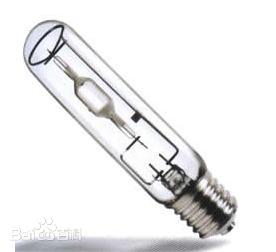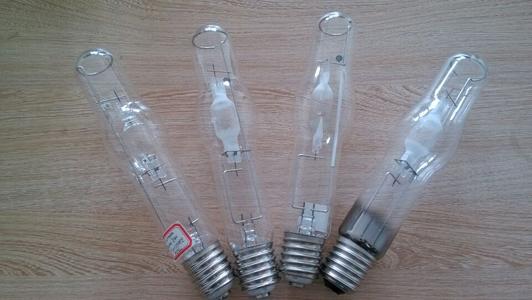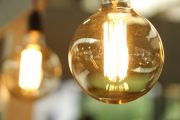Metal halide lamp ballast
The metal halide lamp in the electronic ballast 35W metal halide bulb arc has negative resistance characteristics in all gas discharge lamps; that is, as long as the current through the bulb increases, the voltage across the voltage decreases. If the bulb is powered from a constant voltage source, such as directly from the AC wiring, the current will increase until the bulb destroys itself; therefore, the halide bulb requires an electric ballast to limit the current of the arc.
There are two types of ballasts:
Inductive ballast-Many devices use an inductive ballast, also called a magnetic ballast, similar to those used with fluorescent lamps. This includes an iron core inductor. The inductor provides an impedance to AC current. If the current through the lamp increases, the inductance decreases to maintain the current-limited voltage.
Electronic ballasts-these are lighter and more compact. They consist of an electronic oscillator which generates high frequency current to drive the lamp. Because they have lower resistance losses than magnetic ballasts, they are more energy efficient. However, high frequency operation does not increase lamp efficiency as a fluorescent lamp.
The pulse-started metal halide bulb does not contain a starting electrode, it strikes the arc, and requires an igniter to generate a high voltage (1-5 kV cold strike, 30 kV used in thermal reignition) pulse to start the arc. The electronic ballast includes the igniter circuit in a package. The American National Standards Institute (ANSI) lamp ballast system standard establishes the parameters of all metal halide components (except for some newer products).
Self-ballasted lamps As of 2012, several companies have begun to provide self-ballasted metal halide lamps to directly replace incandescent lamps and self-ballasted mercury lamps. These lamps include an arc tube with a starting electrode, and a tubular halogen lamp, which is connected in series and used to regulate the current in the arc tube. The resistance provides a limited starting electrode current. Like self-ballasted mercury vapor lamps, self-ballasted metal halide lamps are directly connected to the main power source and do not require an external ballast. In contrast to this, these lamps usually have a clear outer bulb without coating, so that the arc tube and halogen tube are clearly visible from the outside.
Color temperature
Due to the whiter and more natural light produced, the metal halide lamp was originally the blue mercury lamp of choice. With the introduction of specialized metal halide mixtures, metal halide lamps are now associated with a correlated color temperature from 3000 K to 20000 K. The color temperature can vary slightly from lamp to lamp, and this effect is obvious where many lamps are used. use. Because the color characteristics of the lamp tend to change during the life of the lamp, according to the ANSI standard that the color after 100 hours (flavoring) is measured after the bulb has been burned. The newer metal halide technology, called “pulse start”, has improved color rendering and a more controllable Kelvin variance (±100 to 200 Kelvin).
The color temperature of the metal halide lamp can also be affected by the electrical characteristics of the bulb and the manufacturing difference of the bulb itself through the power supply of the electrical system. If a metal halide bulb is underpowered because of the lower operating temperature, its light output will be blue because of mercury’s separate evaporation. This phenomenon can be seen during the heating period, when the arc tube has not reached the full working temperature and the halide has not yet completely evaporated. It is also very obvious with dimming ballasts. The inverse is true that a light bulb is too powerful, but this condition may be dangerous and may cause the arc tube to explode due to overheating and overvoltage.
Start-up and warm-up
After power-on, the 400-watt metal halide lamp will soon be “cold” (lower operating temperature) and the metal halide lamp cannot immediately start to produce its full amount of light, because the temperature and pressure in the inner arc chamber takes time to reach the full operating level . It sometimes takes a few seconds to start the initial argon arc welding (or xenon car), and (depending on the bulb type) the warm-up period can be as long as five minutes. During this period, the lamp showed that various metal halides of different colors vaporized in the arc chamber.
If the power supply is interrupted, or even simply, the arc in the lamp is extinguished, and the high pressure present in the thermoluminescent tube will prevent the arc from re-starting; the 5-10 minute cooling period with the normal igniter will be required before the lamp can be restarted , But with a specially designed lamp with a special igniter, the arc can be re-established immediately. In lamps without the ability to reignite instantaneously, a momentary loss of power may mean that there is no light for several minutes. For safety reasons, many metal halide lamps have incandescent lamps that work as backup tungsten halogen lamps during cooling and restriking. Once the metal halide restrikes and heats up, the incandescent light is safely turned off. A warm lamp also often takes more time than a lamp that begins to cool completely to fully exert its brightness.
The strength of all HID arc tubes reduces their lifetime due to various factors such as chemical corrosion, thermal stress and mechanical vibration. As the lamp ages, the arc tube changes color, absorbs light and gets hotter. The tube will continue to become weak until it finally fails, causing the tube to rupture.
Although such failures are associated with the end of life, the arc tube can fail at any time because manufacturing defects such as microcracks are not visible even when it is new. However, this is quite rare. Manufacturers usually inspect new lights in the “peak season” before these defective lights leave the manufacturer’s premises.
Since the metal halide lamp contains a significant high-pressure gas (up to 50 psi), the failure of the arc tube is an inevitable violent event. Fragments of the arc tube are fired at extremely high speeds, in all directions, and there is noticeably enough force on the outer bulb of the lamp to break it. If the luminaire does not have secondary protection (such as lens, bowl or shield), the fragments of extremely hot pieces will fall and hit people and property under the light, which may cause serious injury, damage, and may cause major building fires. If flammable Matter exists.
Metal halide lamp structure and working principle
A metal halide lamp (hereinafter referred to as a metal halide lamp) is a gas discharge lamp that passes through a vaporized gas mixture of mercury and metal halide (bromide or iodine with metal compounds) through a gaseous mixture that generates a light arc.
It is a type of high intensity discharge (HID) gas discharge lamp. Developed in the 1960s, they are similar to mercury vapor lamps, but contain an additional metal halide quartz arc tube, which improves the efficiency and color reproduction of the light.
The most commonly used metal halide is sodium iodide. Once the arc tube reaches its operating temperature, sodium dissociates from iodine, adding orange and red from the spectrum of the sodium D line as the metal ionization. As a result, the metal halide lamp has a higher luminous efficiency, reaching about 75-100 lumens per watt, which is about twice that of mercury, and 3 to 5 times that of vapor lamps and incandescent lamps, and produces strong white light.
The lamp life is 6000 to 15000 hours. Due to the use of one of the most effective sources of CRI white light, metal halides were carried out in 2005 in the fastest growing area of the lighting industry. They are used for wide-area top lighting in commercial, industrial and public places, such as parking lots, sports fields, factories and retail stores, as well as residential security lighting and car headlights (xenon headlights).
The lamp consists of a small fused silica or ceramic arc tube, which contains the gas and arc, which is enclosed with a coating to filter out the ultraviolet light generated inside a larger glass bulb. They work at a pressure of about 20 atmospheres and require special fixtures to operate safely, as well as electric ballasts. Metal atoms produce most of the light output. They need a few minutes of warm-up period to reach full light output.
As one of the most effective sources of high CRI white light, metal halides were the fastest growing field in the lighting industry in 2005. They are used for wide-area ceiling lights in commercial, industrial and public places, such as parking lots, sports fields, factories and retail stores, as well as community security lighting and car headlights (xenon headlights).
The wavelength ranges between 385nm, 422nm, 497nm, 540nm, 564nm, 583nm (the highest), 630nm and 674nm peaks are typical output spectra of metal halide lamps.
Metal halide lamps used as street lights
Metal halide lamps are used for general lighting purposes in both indoor and outdoor, automotive and special applications. Due to their wide spectrum, their use in indoor applications is increasing. In sports facilities, high-intensity light sources such as metal halide lamps are required.
Metal halide lamps are used in car headlights, where they are commonly referred to as “xenon headlights” due to the use of xenon in the bulb instead of gas argon and are typically used in other halide lamps. They produce more intense light than incandescent headlamps.
Another common application of such lamps is in photographic lighting and stage lighting installations, where they are commonly referred to as MSD lamps and usually use watt ratings at 150, 250, 400, 575 and 1200, especially in the field of smart lighting.
Like other gas discharge lamps, such as very similar mercury vapor lamps, metal halide lamps produce a mixture of gases in a light arc. In metal halide lamps, compact arc tubes contain high-pressure mixtures of argon or xenon, mercury, and various metal halides, such as sodium iodide and scandium iodide. The specific mixture of halogenation affects the correlated color temperature and intensity (to make the light More blue, or redder, for example). The argon gas in the lamp is easily ionized, which is beneficial to the arc voltage impinging on the two electrodes first applied to the lamp. The heat generated by the arc, and then vaporized mercury and metal halides, which generate light increases as temperature and pressure increase.
The common working conditions in the arc tube are above 5-50 atmospheres (70-700 pounds or 500-5000 kPa) and 1000-3000℃. Like all other gas discharge lamps, metal halide lamps have negative resistance, and with the rare exception of self-ballasted lamps with filaments, a ballast is required to provide proper starting and operating voltage and to regulate the current flow of the lamp. Approximately 24% of the light (65-115LM/W) generated by the energy used in metal halide lamps makes them substantially more efficient than incandescent bulbs, which typically have an efficiency in the range of 2-4%.
The metal halide lamp consists of a luminous tube with electrodes, an outer bulb and a lamp cap.
Fused Silica Inside the Arc Tube The tungsten of the arc tube is doped with thorium electrodes, which are sealed to each end and the current passed to them is sealed in a fused silica foil with molybdenum. This is the light inside the arc tube that actually builds.
In addition to mercury vapor, the lamp contains iodide or sometimes bromide different metals. In some types of scandium and sodium, thallium, indium and sodium are used in the European tri-salt model, and the more recent type dysprosium has a high color temperature, tin has a lower color temperature, and holmium and thulium are used in some very high power film and television lighting model. Gallium or lead is used for printing purposes in a special high UV-A model. The mixture of metals used defines the color of the lamp. Certain types of festivals or dramatic effects use thallium which is almost pure iodide, green lights, indium, and blue lights.
An alkali metal (sodium or potassium) is almost always added to reduce the arc resistance, allowing the arc tube to be made long enough to be used as a simple electric ballast. An inert gas, usually argon, is cold filled into the arc tube at a pressure of about 2 kPa to promote the initiation of the discharge. Argon-filled lamps are usually slow to start and take several minutes to reach full light intensity; Xenon-filled lamps have better start-up time when used in car headlights.
Metal halide stadium lights
The end of the arc tube is often externally coated with white infrared-reflective zirconium silicate or zirconium oxide to reflect the heat back to the electrode to maintain heat and thermionic emission. Some bulbs have a phosphor coating on the inside of the outer bulb to improve the spectrum and diffuse the light.
In the mid-1980s, a new type of metal halide lamp was developed, which replaced the quartz (fused quartz) arc tube used in the design of mercury vapor lamps and previous metal halide lamps, using a sintered alumina similar to Those with arc tubes are using high-pressure sodium lamps. This development reduces the impact of ion creep that plagues fused silica arc tubes. During its life, sodium and other elements tend to migrate into the quartz tube due to high ultraviolet radiation and gas ionization, which leads to the consumption of recycled luminescent materials. The sintered alumina arc tube does not allow ions to creep through, maintaining a more constant color over the life of the lamp. These are commonly referred to as ceramic metal halide lamps or CMH lamps.
The concept of spectrum modification with the addition of metal iodides (in particular:-yellow, lithium-red, indium-blue, potassium and rubidium-sodium crimson, and thallium-green) mercury arc discharge created the first metal halide lamp that can be Through tracking the patent US1025932 in 1912, Charles Steinmetz transformed the “general electric wizard”.
Metal halide lamps are used in light bulbs outside baseball fields
Most types are equipped with an outer glass bulb to protect the internal components and prevent heat loss. The outer bubble can also be used to block some or all of the ultraviolet light generated by mercury vapor discharge, and can be specially doped with “ultraviolet stop” fused silica. UV protection is a single-ended (single base) model and a double-ended model, which are commonly used for lighting near humans. Some high-powered models, especially lead, gallium UV printed models and models used for certain types of stadium lighting do not have external light bulbs. The use of bare arc tubes in the permissible optical system of UV or precisely positioned transmission lamps. The cover glass of lighting equipment can be used to block ultraviolet rays, and it can also protect people or equipment if the lamp should fail by an explosion.
Some types have Edison spiral metal based, with various power ratings between 10 and 18,000 watts. Other types of double-ended, as described above, are constructed with ceramics, with a metal connection between the inside of the arc tube and the outside along the R7S-24 base. These are made up of various alloys (such as iron-cobalt-nickel) with matching thermal expansion coefficients of the arc tube.







